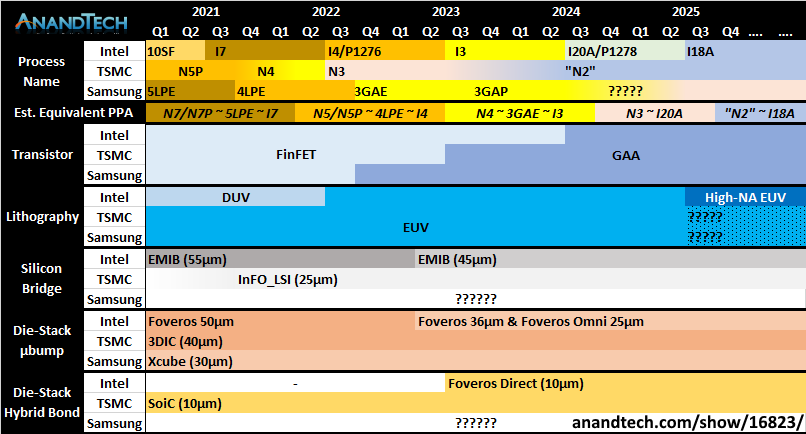Intel's Process Roadmap to 2025: with 4nm, 3nm, 20A and 18A?!
by Dr. Ian Cutress on July 26, 2021 5:00 PM ESTCustomers Customers Customers
As a roadmap announcement today, the focus isn’t so much on the customers but on the technology. Because Intel is moving into a phase where it expects its IFS offerings to compete against the established players, it has to consider its disclosures with respect to both its internal use and any external interest, which is a new concept for the company – at least on this scale compared to its previous foundry efforts.
Intel CEO Pat Gelsinger, in the company’s Q3 financial call last week, was keen to point out that they already have a large hyperscaler customer signed up for their next generation packaging technology, however today there would appear to also be another customer in the mix. Now we assume that Intel’s Foundry Services is talking to 100s of chip companies, big and small, but it doesn’t take much to sign an NDA to start to talk – what will be interesting is when customers start making commitments to using Intel’s facilities, and if any of those are volume orders.
As part of the announcement today, Intel held a little bit back from us, saying that they are saving some of the details specifically for the event that is going on as we publish this piece. All we know is that our draft press release has a big yellow bar that says ‘[customer news]’ on it, right next to Intel’s 20A process node details.
For reference, Intel 20A is a 2024 technology using first generation Gate-All-Around transistors, marketed as RibbonFETs, as well as backside power delivery, marketed as PowerVias. At this time Intel expects to have second/third-generation EMIB available as well as fourth-generation Foveros Direct. So if a customer is already committing to Intel 20A, there’s going to be a lot of potential here.
When the announcement is made, we will update this news article.
To conclude, Intel maintains that these roadmaps will showcase a clear path to process performance leadership* by 2025. It’s a tall order, and the company has to execute better than it has in recent memory - but that’s kind of why the company has rehired a number of former Intel experts and fellows in research, product design, and execution.
*as measured by performance per watt at iso-power
Here's a secondary comparison chart (compared to the one on page one) with all three main foundry offerings listed in each of the main segments that Intel has discussed today.











326 Comments
View All Comments
yannigr2 - Tuesday, July 27, 2021 - link
This is probably the only site on the Internet that swallows Intel's marketing and puts(on the title) "3nm" next to Intel's name.I would expect better from this site.
I guess Intel is hiring.
mode_13h - Tuesday, July 27, 2021 - link
Good point. Even Intel doesn't call it "3 nm". They call it "Intel 3". The title shouldn't misrepresent what they're actually saying.zodiacfml - Tuesday, July 27, 2021 - link
i agree. can't believe theyre just eating all this crap whereas they could have easily investigated Intel's 10nm 8 core laptop vs. AMD/TSMC 7nm laptop chips.29a - Tuesday, July 27, 2021 - link
It's become quite the shitshow since Anand sold the site, I'm only now realizing he sold it to FoxNews.ET - Tuesday, July 27, 2021 - link
It's certainly an aggressive roadmap. I'll be waiting to see how it turns out.mode_13h - Tuesday, July 27, 2021 - link
Intel's process roadmaps have never lacked in ambition.Timoo - Tuesday, July 27, 2021 - link
Ah, you have to firgive them. They simply didn't understand yet that the slave boats with 2 whipmen and hundreds of rowers have been "out of fashion" for quite some time now.siuba - Tuesday, July 27, 2021 - link
intel 7nm (intel 4) ... the table information incorrect.. it should be 200MTr/mm2+.. 5/4nm (Intel 3) density still unknown..Gondalf - Tuesday, July 27, 2021 - link
Looking at the suboptimal density found in Apple A14 SOC (5nm TSMC), this look like a good roadmap. We must remember that TSMC does a lot of claims about great density, still we find disappointing results in final products.There is too much enphasis on density, a lot less on availability of the process across the customers and a lot less about real yields at the claimed high density.
Bet in these days many have pissed off TSMC (Automotive, Nvidia in primis). A lot of claims but in pratics TSMC can not satisfy the demand cause low yields, simple and plain. AMD is a good example of the disaster. Qualcomm large utilization of Samsung say a lot.
name99 - Tuesday, July 27, 2021 - link
This statement about TSMC is a strong claim. The ONLY validated TSMC 5 density we have is A14/M1 and those are weird cases bcs Apple’s ONLY priority with them was to ship on time and working correctly (as far as x86/Mac transition matters). Physical optimization may have been tossed overboard as schedule slipped.There are claims that the Huaiwei chip fabbed on N5 met TSMC density as expected, but since few have seen that chip (bcs US forced Huawei off TSMC) who knows?
I’d wait for an alternative chip on N5 (should be one soon, surely) before making strong density claims.